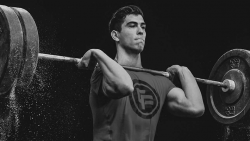As one of the most physically demanding sports out there, rugby requires players to have strength, power, speed, and agility in order to perform at their best on the field.
While skill and technique are certainly important, a strong physical foundation is essential for success.
In this article, we will explore the ten exercises that every rugby player should be doing in order to improve their performance,
Let’s get this party started.

10 Exercises Every Rugby Player Should Be Doing
Take your rugby game to the next level with these 10 exercises.
Power Cleans
Power Cleans are the ultimate rugby exercise. They build the power, strength, and explosiveness that rugby players need to dominate the field.
But that’s not all – power cleans also serve as a catalyst for overall strength and coordination, which are critical for rugby players who need to perform a plethora of movements and skills. This exercise demands a harmonious interplay between the lower and upper body, thereby forging an impressive level of athleticism that sets rugby players apart from the rest of the pack.
The only downside of power cleans is that it can take time to learn to perform them correctly. You should get with a strength coach to make sure you are using the correct form, or you can get injured.
A common alternative to power cleans are med ball tosses which are very similar movements to power cleans but don’t have the learning curve. The overhead tosses are especially similar to the power clean. We will cover med ball tosses later, though.
Deadlifts
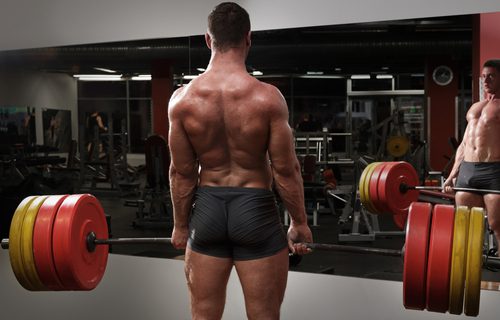
Deadlifts are the king of all weightlifting exercises, and they are pretty much mandatory for rugby players.
Deadlifts are a veritable powerhouse of an exercise for rugby players, targeting multiple muscle groups in the lower body, including the hamstrings, glutes, and lower back.
These muscle groups are absolutely pivotal for rugby players, serving a crucial role in executing the intense demands of running, tackling, jumping, and other movements that par for the course on the field of play.
The trap bar deadlift is a great variation for rugby players and all other athletes. It allows you to have a neutral spine with the weight centered below you rather than in front of you which is better for preventing injury.
Squats
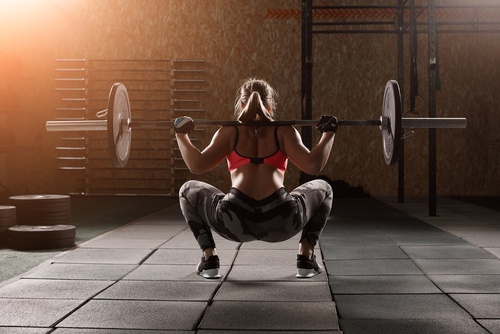
To the surprise of no one, squats are next on the list as one of the best exercises for rugby players.
Let me tell you. They are hands down one of the best exercises for rugby players. And the reason? They’re a powerhouse move that works multiple muscle groups in the lower body. Yeah, you heard me right. We’re talking about the quadriceps, hamstrings, glutes, and calves. These are the very same muscles that rugby players need to generate explosive power and speed on the field.
And it doesn’t stop there. Squats are also an excellent way for rugby players to build resilience and endurance, two qualities that are absolutely essential in a contact sport like rugby. With every squat, these players can strengthen their lower body muscles and improve their ability to perform tasks such as running, tackling, and pushing during scrums.
While back squats are generally the most popular squat, you can also use varieties like the Belgian Split Squats, front squats, goblet squats and even jump squats.
Bench Press
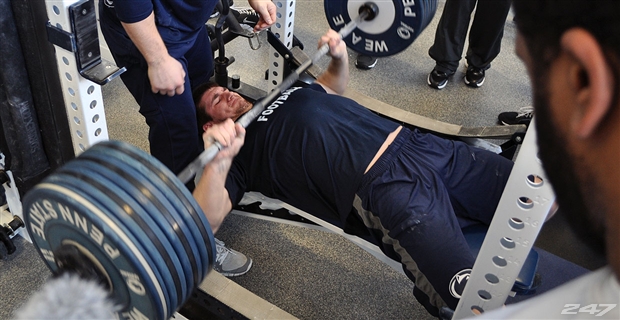
Next up, we have the king of upper body exercises with the bench press. I’m sure this one isn’t much of a surprise to you either.
This exercise is a classic compound movement that specifically targets the chest, shoulders, and triceps muscles, which are essential for pushing and tackling on the field.
Rugby is a brutal contact sport that demands a lot of upper-body strength, and the bench press is a perfect way to develop that strength and power. It’s like adding fuel to the fire, baby! This exercise will help players to drive through contact and tackle opponents with authority.
But it doesn’t stop there. The bench press is also a fantastic exercise for developing upper body stability and control, which is crucial for rugby players during scrums and lineouts. These are set-piece situations that require high levels of upper-body contact, and a strong chest and shoulder girdle can help players maintain their position and dominate their opponents.
Sled Pushes and Pulls
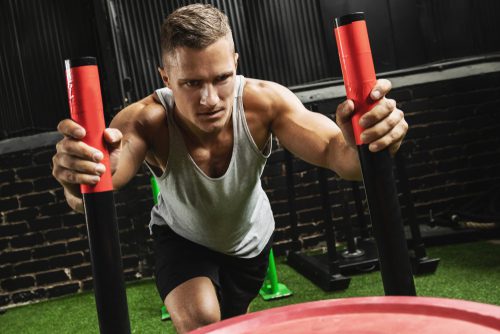
If you are gonna play rugby, you are going to need to have some good leg drive to help you break threw tackles and when in a scrum.
Picture this: you’re on the field, and the game is in full swing. You need to generate explosive speed and power to push through contact and tackle those opponents. That’s where sled pushes and pulls come in! These exercises are a surefire way to develop those quads, hamstrings, glutes, and calves, which are all key muscle groups for rugby athletes.
But it doesn’t stop there. Sled pushes and pulls also help to improve your anaerobic capacity and overall endurance. Let’s face it; rugby is an intense sport that requires you to dig deep and push your limits. Sled pushes and pulls will help you develop the necessary cardiovascular fitness and muscular endurance required to keep you going strong until the final whistle.
On top of all that, pulling and pushing sleds has been shown to increase sprint acceleration. A topic we covered extensively in our article on Light vs Heavy Sled Pulls for Sprinting.
Every athlete should be doing sled training, especially rugby players.
Plyometrics

Rugby training isn’t just about being strong as an ox, although that is a big part of it.
If you want to take your performance on the field to the next level, you better be doing plyometric exercises. Plyometrics are all about explosive, high-intensity movements that will help you develop power, speed, and agility like never before.
Picture this: you’re on the field, and the ball is in play. You need to jump higher, run faster, and change direction quickly to dodge those defenders and score that try. That’s where plyometric exercises come in handy! They’ll help you develop the explosive power you need to perform these movements at a high level.
Plyometric exercises work by using quick, explosive movements that engage your muscles to generate a lot of force in a short amount of time. This type of training is fantastic for increasing the strength and power of the muscles involved in the movement.
A few plyometric exercises that would be good for rugby players include jump squats, box jumps, and lateral bounds.
See our article on the best plyometric exercises for athletes to get a complete rundown on what plyometrics is and more exercises.,
Core Exercises
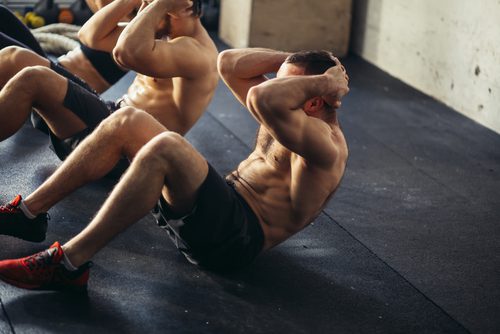
An often underrated and sometimes forgotten about exercise for rugby players and every other athlete out there is core training.
Think about it: rugby requires you to perform explosive movements, change direction quickly, and withstand the forces of tackles and scrums. Your core muscles are the key to executing all of these movements with power and control. A strong core can help you generate more force, transfer power more efficiently, and maintain your balance and stability in the face of opposition.
But wait, there’s more! Core training can also help reduce the risk of injuries. Rugby players are no strangers to getting banged up on the field, and a strong core can help you withstand the forces of tackles and scrums without getting injured. Plus, by improving your posture and reducing lower back pain, core training can help you stay healthy and performing at your best for longer.
So what kind of core exercises should you be doing? There are plenty of options to choose from, including plank variations, Russian twists, and medicine ball throws. And the best part is, you can customize your routine to suit your fitness level and training goals.
Med Ball Throws
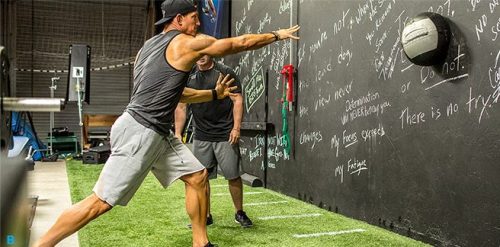
Looking to build power and explosiveness? Med throws are a great tool to help yoo do just that.
Med ball throws asl0 help you increase your rotational strength which is critical for many rugby movements. For example, when a player is tackling or fending off an opponent, they need to be able to rotate their torso quickly and efficiently. Med ball throws can help to build the rotational strength required for these movements, making players more effective on the field.
Not only that, medicine ball throws can help rugby players develop functional movement patterns that translate directly to rugby performance. The movements involved in med ball throws mimic many of the movements required in rugby, such as throwing, twisting, and jumping. By training these movements, rugby players can improve their overall athleticism and performance on the field.
Some examples of medicine ball throws that rugby players can incorporate into their training routine include overhead throws, chest passes, and rotational throws.
Agility Drills
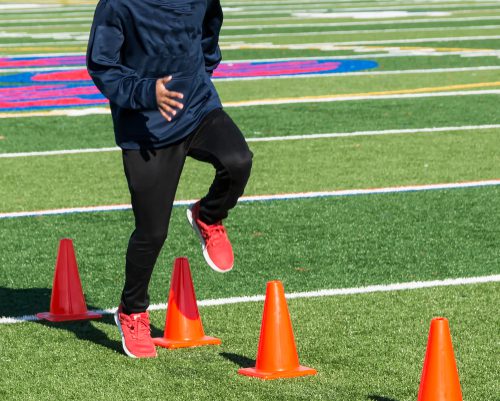
Agility drills are an absolute must-have in the training regimen of rugby players. These drills help rugby players to enhance their speed, coordination, and agility on the field, which is essential for dominating the game. Rugby is a fast-paced sport that demands players to change direction quickly, evade defenders, and react to unpredictable situations. Agility training can help rugby players develop the explosive movements and sharp reflexes required to excel in these scenarios, making it a crucial component of rugby training.
The most significant benefit of agility training is improved speed. By practicing agility drills, rugby players can improve their ability to accelerate and decelerate quickly, which is essential for chasing down opponents or making sudden stops on the field. Agility training can also enhance lateral movement, which is crucial for side-stepping defenders and changing direction rapidly.
Another important benefit of agility training is that it helps rugby players improve their coordination and balance. Agility drills usually involve the use of multiple muscle groups and challenge the player’s balance and coordination. By practicing these drills regularly, rugby players can enhance their overall coordination and balance, making them more effective and efficient on the field.
Running/Conditioning
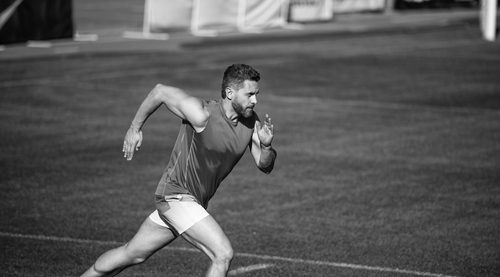
In all the research I did for this article, I really didn’t find anyone talking about running and conditioning as being essential for rugby.
Hello!?!? This isn’t baseball. You have to be in great cardiovascular shape if you are going to dominate the rugby field.
Rugby players need to be able to run for extended periods of time, change direction quickly, and maintain explosive bursts of energy.
Running and conditioning training can help rugby players develop the necessary physical attributes required to perform at their best on the field.
Let’s be real. Rugby games are typically played over 80 minutes, which is a long time to maintain high-intensity activity. If you aren’t in great shape, you won’t be able to help your team, particularly at the end of games.
Some examples of running and conditioning drills that rugby players can incorporate into their training routine include interval training, hill sprints, and shuttle runs. These exercises can be customized to suit the player’s level of fitness and training goals and can be performed individually or as part of a team training session.
Wrap Up
Well, well, well – looks like we’ve reached the end of our journey through the top ten exercises that every rugby player should be doing. It’s been quite the ride, hasn’t it? We’ve talked about everything from squatting to sled pushing, and we’ve covered why each exercise is important for building the strength, power, and endurance that rugby players need to dominate on the field.
But let’s not kid ourselves – rugby is not a sport for sissies. It’s a game that demands grit, determination, and a willingness to push yourself to the limit. That’s why these ten exercises are so crucial for rugby players. They’re not just exercises – they’re tools that players can use to hone their physical and mental toughness and to become the best rugby athletes they can be.
So whether you’re a seasoned rugby pro or a newbie looking to make your mark in the sport, take these exercises to heart. Incorporate them into your training routine, and watch as you become faster, stronger, and more resilient on the field. With the right training and mindset, there’s no limit to what you can achieve in rugby. So go out there and make it happen.

Ryan is a former college wrestler and lifelong fitness fanatic. He has run half marathons, done mud runs, placed in body transformation contests, coached wrestling, and now coaches girls’ soccer. Not to mention he has also tried literally hundreds of supplements over the years and has a vast and thorough supplement knowledge. He has written for Muscle & Strength, Testosterone Junkie, The Sport Review and other publications. He is also the editor-in-chief of this website and has over 25 years of experience in the fitness industry. Feel free to connect with him on his LinkedIn page below.




